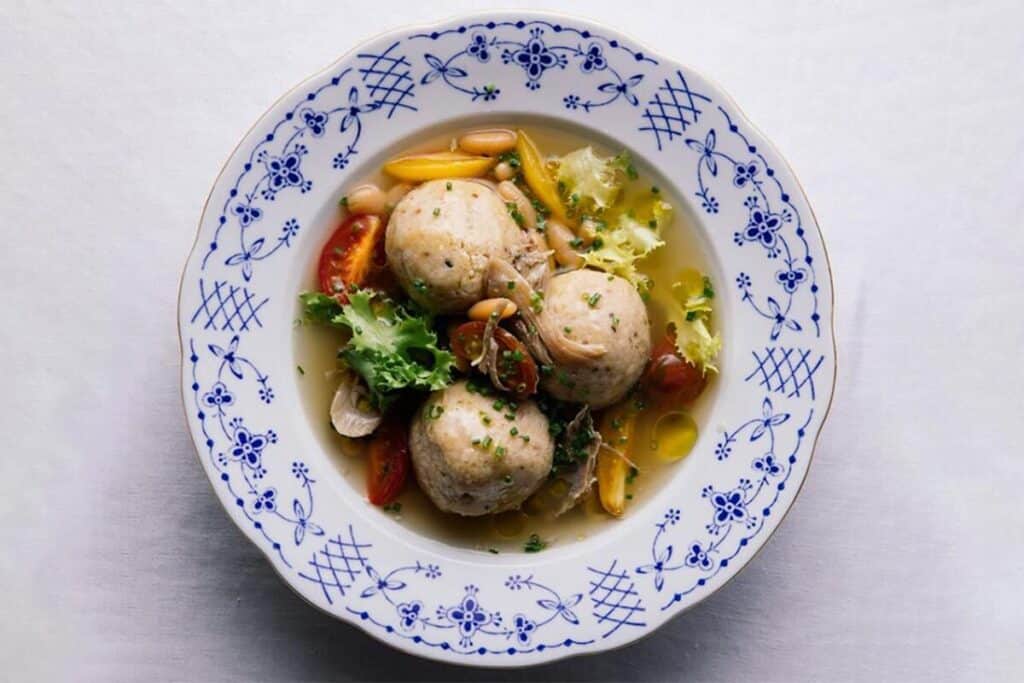
Alon Shaya is Chef-Partner of Pomegranate Hospitality, which includes Saba and Saba’s Lounge in New Orleans, Safta in Denver, and Miss River and Chandelier Bar at the Four Seasons Hotel New Orleans.
Born in Israel, raised in Philadelphia, and a proud New Orleanian, Alon has always had a deep love and appreciation for food and the singular way restaurants anchor their communities.
This merging of an Italian-American and a Jewish classic — matzo-ball soup and Italian wedding soup — feels almost second nature to me, given my culinary upbringing.
Every Rosh Hashanah and Passover, I’d work on showcasing what the Jews would eat in the Italian ghettos. That’s how this soup came about.
The foundation of deep, savory flavors is in the stock, and this recipe has two of them. The duck and chicken stock is the soup itself, full-bodied, rich, and deeply soothing.
The second stock, in which you cook the matzo balls, uses the first stock’s spent solids, a thrifty French technique called remouillage that makes the most of every ingredient.
These take time but little effort, and there are a couple of ways you can make this recipe fit your timeline and keep it super-manageable.
You can knock it all out in a long, lazy day at home, make both stocks (and the duck meat) in advance and refrigerate them all separately, or add the duck back to its stock and freeze.
You can also prepare the matzo balls first, cook them in water or any other broth, and make only the duck stock.
Some people have a weird reaction to chicken feet. They do look sort of like dinosaurs’ hands, but they’re totally safe to eat. They’re available in many grocery stores’ poultry sections (or you can ask the person at the butcher counter), but wings also make a really great substitute.
Chef Alon Shaya’s matzo ball wedding soup
PrintIngredients
- 1 duck (5 to 6 pounds)
- 3 lbs chicken feet
- 1 gallon plus 3 quarts water, divided
- 1 yellow onion, quartered
- 1 carrot, peeled and chopped
- 2 stalks celery, chopped
- 3 sprigs fresh thyme
- 3 tbsp plus 2 teaspoons Morton kosher salt, divided
- 1 cinnamon stick
- 8 whole allspice berries
- 2 star anise pods
- 2 dried bay leaves
- 1 tsp whole coriander seeds
- 1 tsp whole black peppercorn
- 1 ⅓ cups matzo meal
- ¾ tsp onion powder
- ¾ tsp garlic powder
- ½ cup schmaltz (recipe below) or ghee, melted
- 4 eggs
- 2 cups cherry tomatoes, quartered
- 1 quart lightly packed fresh arugula
- 1 tbsp lemon juice
- Best quality extra-virgin olive oil, for serving
Schmaltz and gribenes
Yield: about ½ cup of schmaltz and 1 heaping cup of gribenes
- Skins and fat from 2 whole chickens (about 1 pound total; see procedure)
- 1 tsp Morton kosher salt
Instructions
Soup preparation:
- Lay the duck on a cutting board, breast side up, with the legs facing you. Discard the giblets and neck, or save them for another use. With your knife angled toward the body, cut through the seam between the thigh and the breast. Once you hit the hip joint, pop it loose with your hands, and slice through it to separate the legs.
- Keeping your knife very close to the bone so you don’t waste any meat, carve along either side of the breastplate and the ribs to remove the meat. Pull the wings out, away from the body, and cut through the ball joint that attaches each of them to the breast (pop it with your hands, as you did the hip joint, if you have trouble getting through). Set the legs and wings aside to come to room temperature (you’ll be cooking them in about 1 hour) and refrigerate the breasts.
- In a large stockpot, combine the duck’s carcass with the chicken feet and 1 gallon water over high heat. Once the water is simmering, reduce the heat to medium and skim away any foam. Continue to simmer, skimming frequently, for about 10 minutes, until you’ve removed as much of the foam as you can.
- Add the onion, carrot, celery, thyme, 1 tablespoon of salt, and all the spices. Gently simmer, uncovered, for about 1 ½ hours, until the chicken feet have softened but are not falling apart and all the aromas in the broth are coming together. Decrease the heat a bit if the stock is bubbling too rapidly.
- Submerge the duck legs and wings in the stock, and cook for another 75 to 90 minutes, until the meat is pulling away from the bone (the wings may fall apart). Pull them out and reserve, then add the duck breasts to the stock and cook for just another 15 minutes or so, until they’re firm to the touch and no longer pink in the center. Reserve with the rest of the meat, and remove the pot from the heat.
- Once the duck meat is cool enough to handle, trim away and discard all the skin and any remaining fat. Slice the breast against the grain, and then cut it into bite-sized pieces; pull the meat off the legs and wings, and roughly chop it. Store all the duck meat in the refrigerator until the soup is ready.
- Strain the duck stock, reserving the solids, and allow the stock to cool. You’ll see some fat rise to the top, which adds flavor and body, but you can skim away some or all of it. While it’s cooling, make the second stock: Add all the solids to a separate wide pot or Dutch oven, which you’ll later use to cook the matzo balls, and cover them with 3 quarts of water and 2 tablespoons of salt. Bring to a boil over high heat, then reduce the heat to medium, and continue to simmer for about 30 minutes, until it’s fragrant and tastes well seasoned.
- While the second stock simmers, make the matzo balls: In a large bowl, combine the matzo meal, onion powder, garlic powder, and remaining 2 teaspoons of salt. Separately, beat the schmaltz and eggs together, and then add them to the dry ingredients and stir until well combined, with no dry pockets of matzo meal. Press a sheet of plastic wrap directly onto the surface of the dough, and refrigerate for at least 1 hour and up to 4 hours.
- Strain the second stock (discard exhausted-looking solids), and either store it for later use or, if you are finishing the recipe now, return it to the same wide pot and bring it up to a simmer over medium heat.
- Roll the chilled matzo-ball dough into tablespoon-sized balls, and as soon as you shape them, drop them into the second stock; they should float in a single layer with a bit of room between them (they will expand as they cook). Leaving the heat on medium, partially cover the pot to cook for about 1 hour. The matzo balls are done when they’re the same color throughout; if you cut one open, it should have the same texture as pound cake. Cover, and remove the pot from the heat while you assemble the soup.
- Put the duck stock back in your large pot, and bring it to a simmer over medium heat. Reduce the heat to low, and immediately add the duck meat, tomatoes, arugula, and lemon juice. To serve: Place a couple of matzo balls at the bottom of each bowl, then ladle the soup over it. (The broth you used to cook the matzo balls can be discarded.) Finish with a drizzle of olive oil.
Schmaltz and gribenes preparation:
- Heat the oven to 350°F, and line a large-rimmed baking sheet with parchment paper.
- If you’re cutting the skin directly from the chickens, use your knife to make shallow incisions and, keeping the blade nearly flush with the chicken’s body, cut through all the connective tissue to loosen the skin without cutting into the meat. Work your way around the chicken to remove all the skin piece by piece, and set it aside. Trim away any visible white fat on the outside of the chicken, and save that, too.
- Lay the chicken skins flat on a cutting board, and thoroughly pat them dry, then cut them into 1-to-2-inch pieces. (They’re slippery, so kitchen shears can make an easier job of this, or you can lay them flat and freeze them until they’ve solidified a bit before cutting.) Spread them and the reserved fat on the baking sheet, and sprinkle with the salt. Bake for about 1 hour, until the skins are very crisp and evenly golden.
- Line a plate with paper towels. With a slotted spatula or spoon, move the skins to the plate to drain until they’ve completely cooled. They’re your gribenes.
- When the baking sheet is cool enough to handle, carefully pour the rendered fat into a clean jar for safekeeping. That’s your schmaltz.
Originally Published Mar 15, 2023 10:13PM EDT
